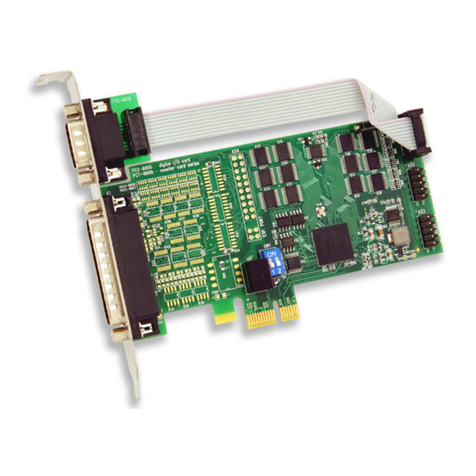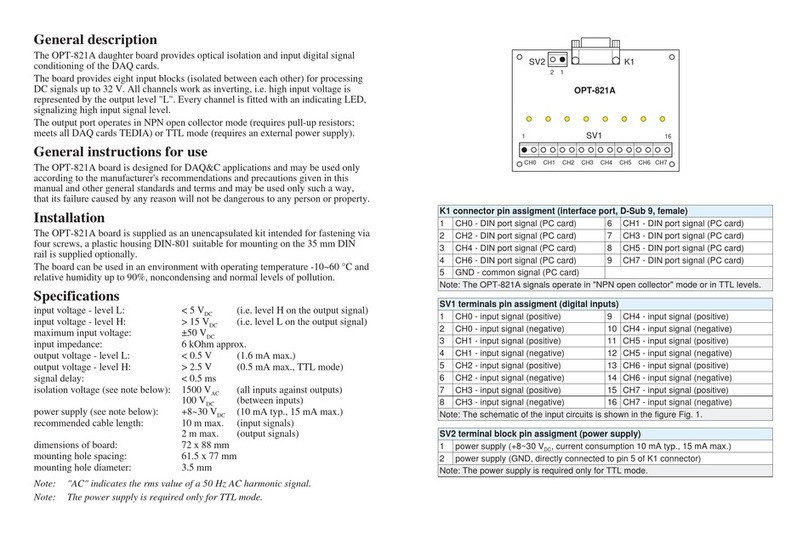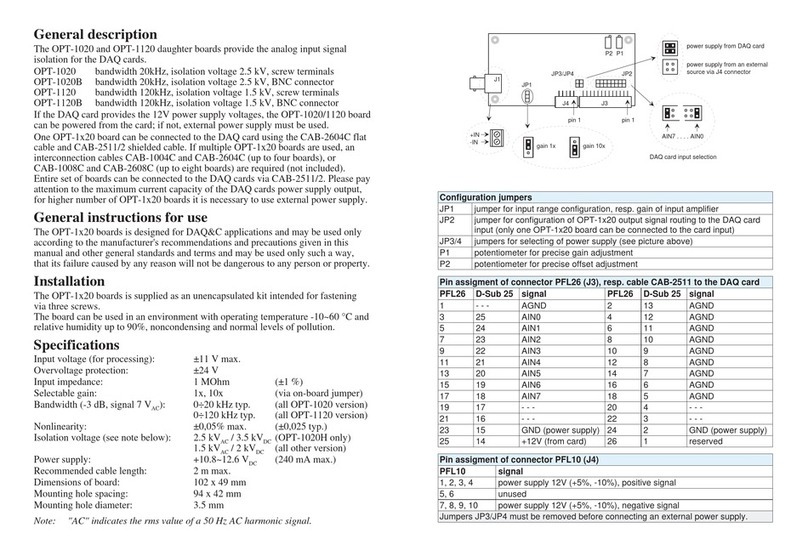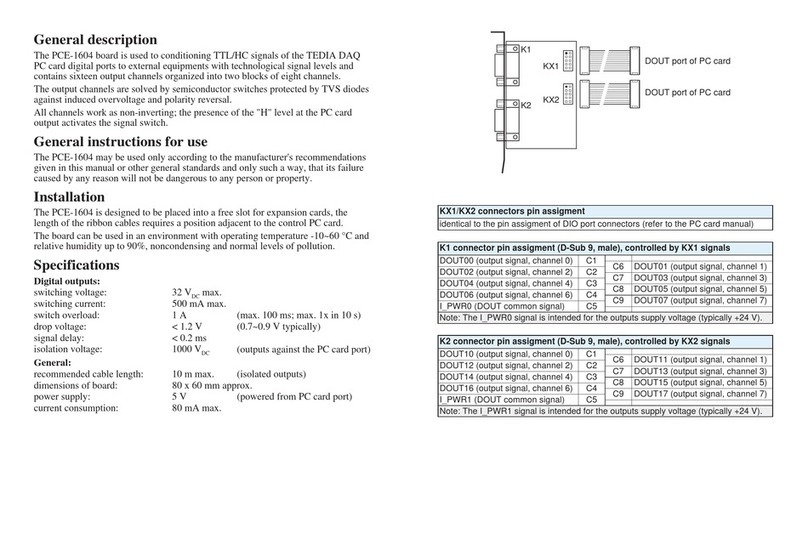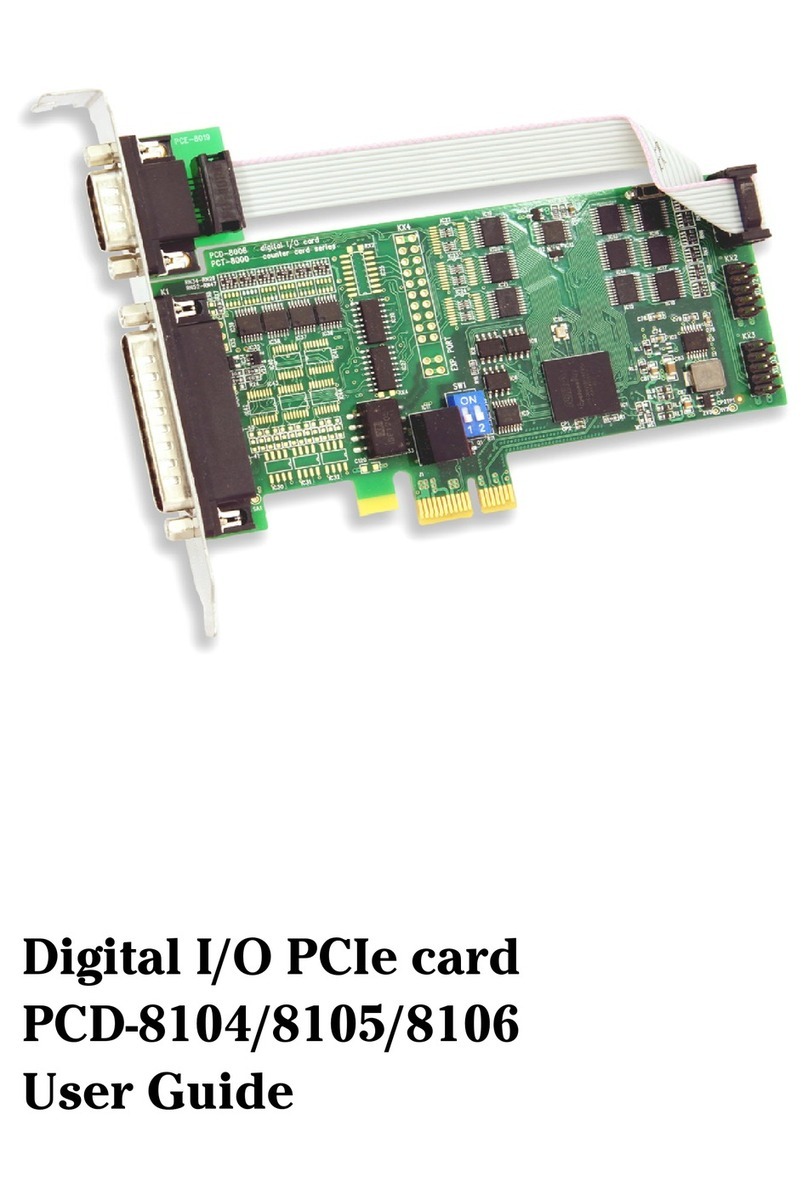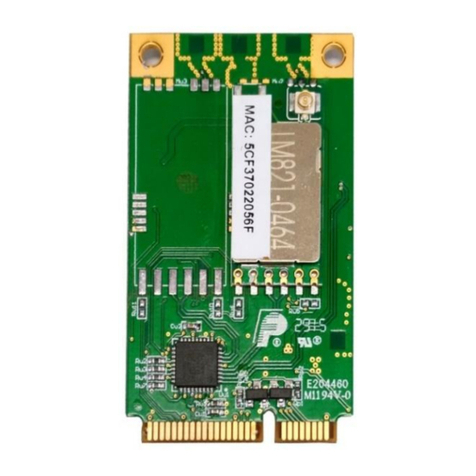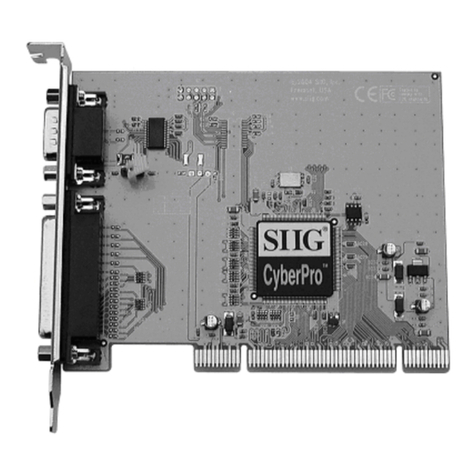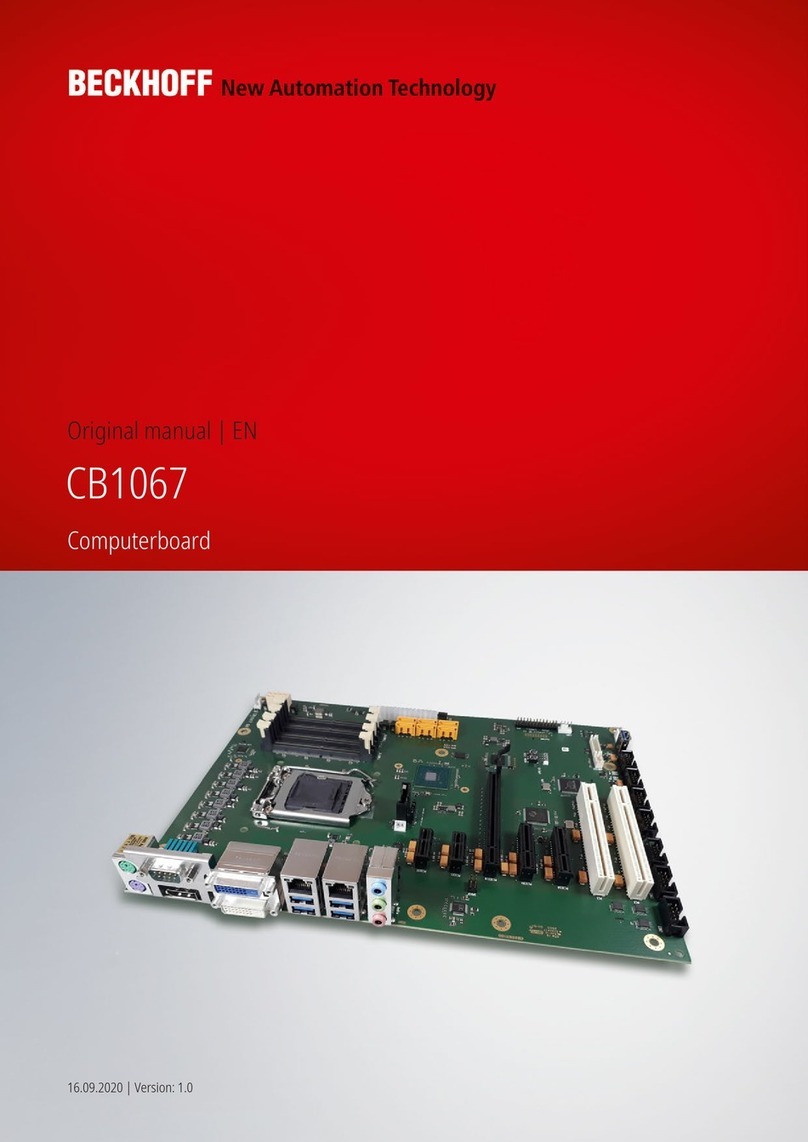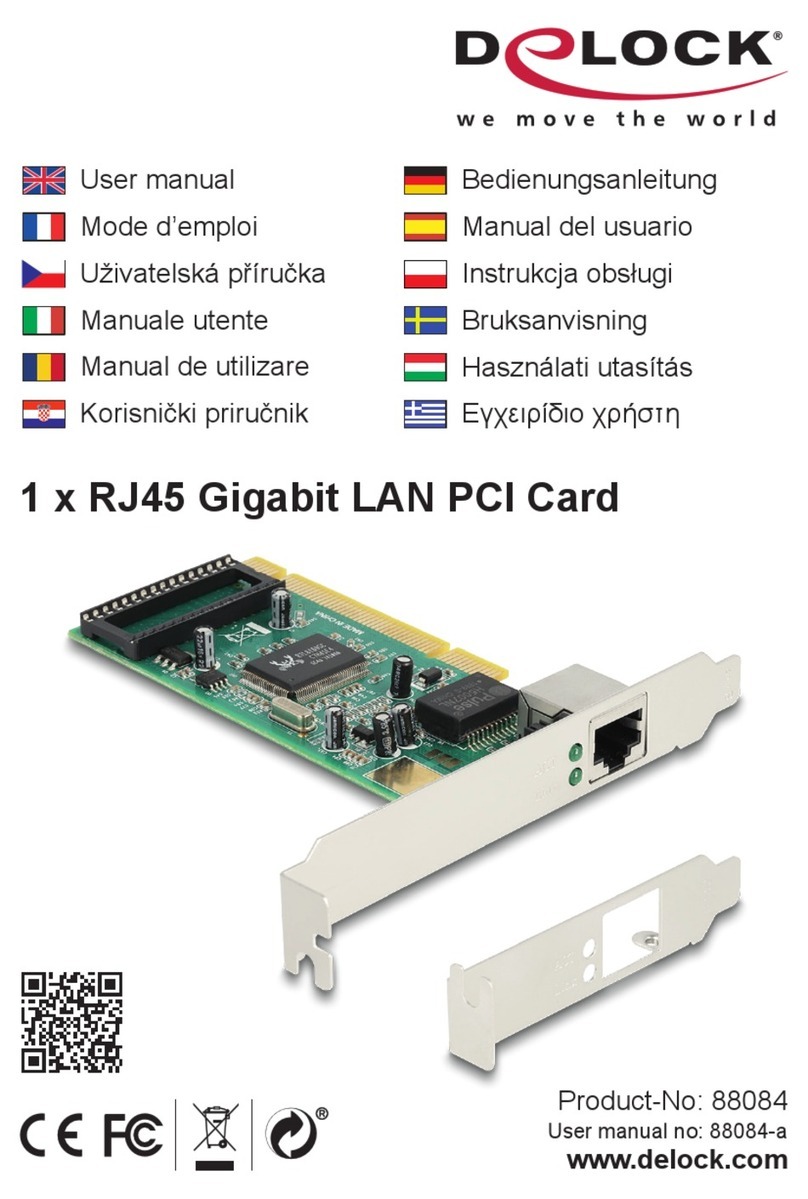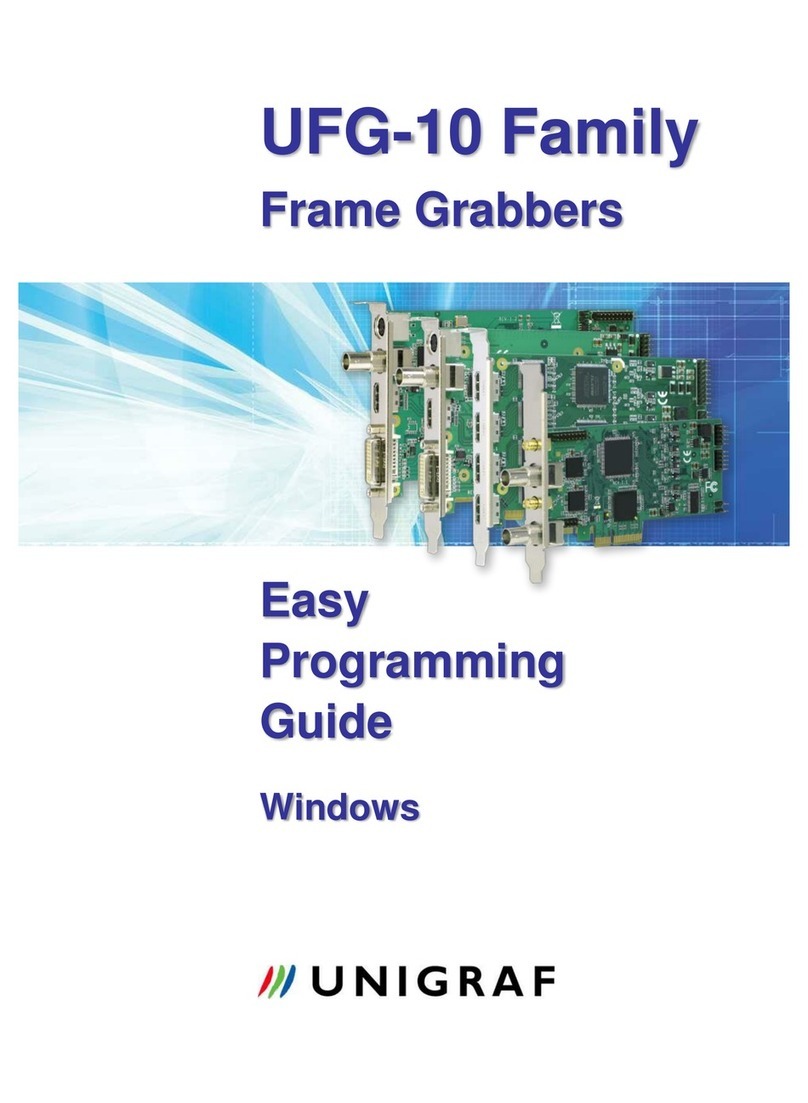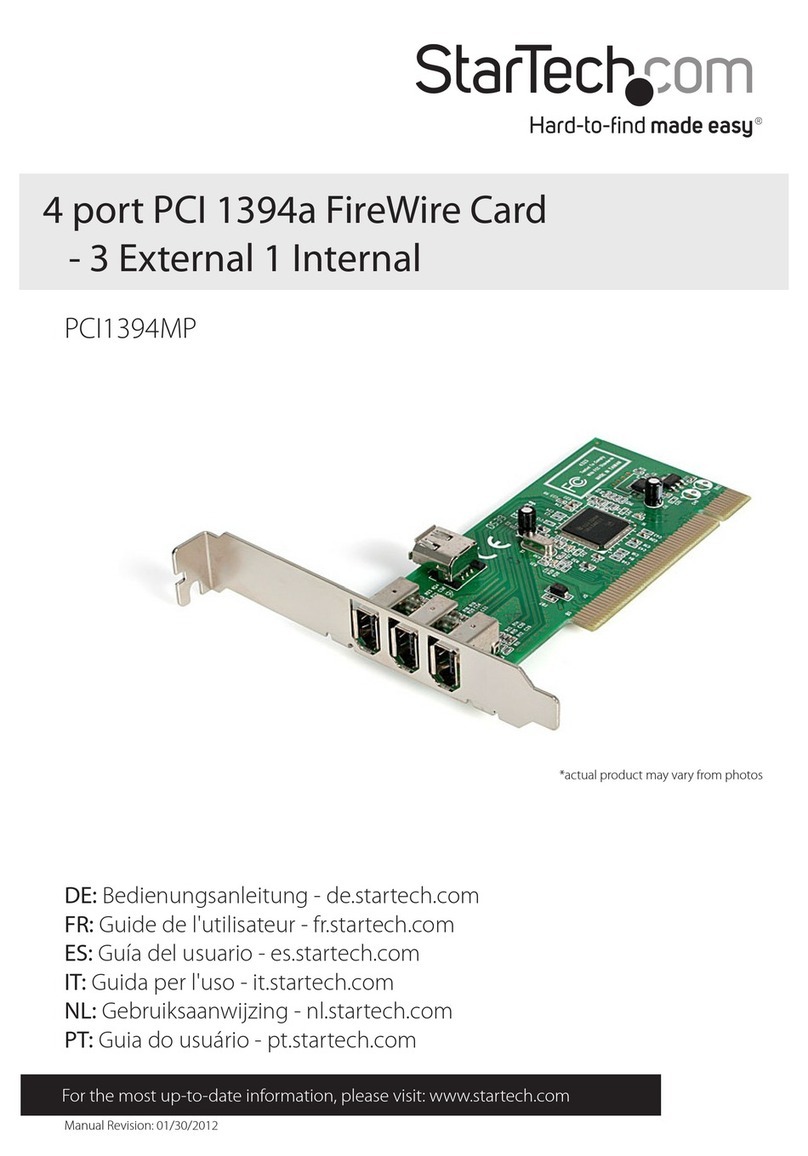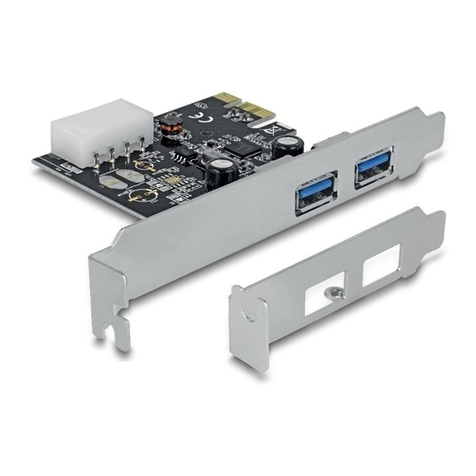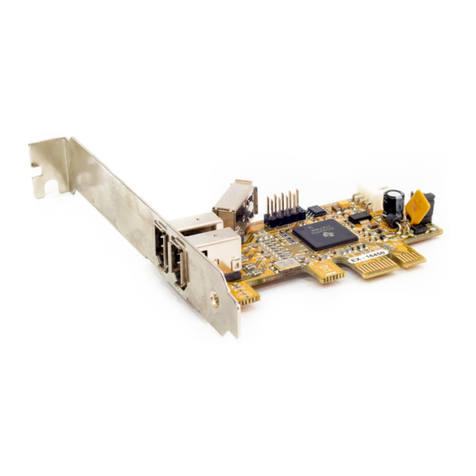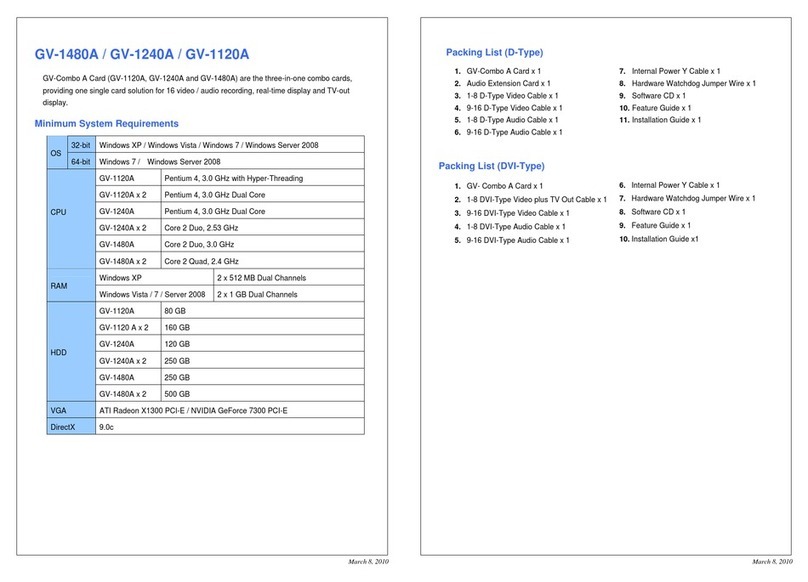TEDIA PCA-8428 User manual

Multifunctional DAQ PCIe card
PCA-8428/8429/8438/8439
User Guide

Manufacturing, sales office, service center, technical support and headquarters:
address: TEDIA®spol. s r. o.
Zábělská 12
31211 Plzeň
Czech Republic
website: http://www.tedia.eu
phone/e-mail: https://www.tedia.eu/contacts
tech. support: https://www.tedia.eu/support
Trademarks:
TEDIA is a registered trademark of TEDIA®spol. s r. o. All other trademarks or registered
marks in this manual belong to their respective owners.
Disclaimer:
This manual has been carefully reviewed for technical accuracy. In the event that technical or
typographical errors exist, TEDIA®reserves the right to make changes to subsequent editions
of this document without prior notice to holders of this edition.
TEDIA®provides this document “as is,” without warranty of any kind, either expressed or
implied, including, but not limited to, its particular purpose. TEDIA®reserves the right to make
improvements and/or changes to this manual, or to the products and/or the programs
described in this manual, at any time.
Information provided in this manual is intended to be accurate and reliable. The reader
should contact TEDIA®, if errors are suspected. In no event shall TEDIA®be held liable for any
form of damage arising out of or related to this document or the information contained in it.
Copyright © 1994÷2015 TEDIA®spol. s r. o., All rights reserved.
My DAQ Card Details:
type of card: . . . . . . . . . . . . . . . . . . . . . . . . . . . . . . . . . . (e.g. PCA-8428)
serial number: . . . . . . . . . . . . . . . . . . . . . . . . . . . . . . . . . . (e.g. 84010108)
purchase date: . . . . . . . . . . . . . . . . . . . . . . . . . . . . . . . . . .
card owner: . . . . . . . . . . . . . . . . . . . . . . . . . . . . . . . . . .

CE Declaration of Conformity, WEEE
1. Introduction
1.1 Description . . . . . . . . . . . . . . . . . . . . . . . . . . . . . . . . . . . . . . . . . . . . . . . . . . . I - 1
1.2 General instructions for use . . . . . . . . . . . . . . . . . . . . . . . . . . . . . . . . . . . . . . I - 1
1.3 Note on the contents of the manual . . . . . . . . . . . . . . . . . . . . . . . . . . . . . . . . I - 1
1.4 New firmware versions and customer´s firmware . . . . . . . . . . . . . . . . . . . . I - 1
2. Specifications
2.1 Analog itputs . . . . . . . . . . . . . . . . . . . . . . . . . . . . . . . . . . . . . . . . . . . . . . . . . . I - 2
2.2 Analog outputs . . . . . . . . . . . . . . . . . . . . . . . . . . . . . . . . . . . . . . . . . . . . . . . . I - 2
2.3 Counters and encoders . . . . . . . . . . . . . . . . . . . . . . . . . . . . . . . . . . . . . . . . . I - 3
2.4 Digital ports . . . . . . . . . . . . . . . . . . . . . . . . . . . . . . . . . . . . . . . . . . . . . . . . . . . I - 3
2.5 Trigger and scan logic . . . . . . . . . . . . . . . . . . . . . . . . . . . . . . . . . . . . . . . . . . I - 3
2.6 Interrupt logic . . . . . . . . . . . . . . . . . . . . . . . . . . . . . . . . . . . . . . . . . . . . . . . . . I - 4
2.7 General data . . . . . . . . . . . . . . . . . . . . . . . . . . . . . . . . . . . . . . . . . . . . . . . . . . . I - 4
3. Installation
3.1 Introduction . . . . . . . . . . . . . . . . . . . . . . . . . . . . . . . . . . . . . . . . . . . . . . . . . . . I - 5
3.2 Hardware configuration . . . . . . . . . . . . . . . . . . . . . . . . . . . . . . . . . . . . . . . . . . I - 5
3.3 Installation . . . . . . . . . . . . . . . . . . . . . . . . . . . . . . . . . . . . . . . . . . . . . . . . . . . . I - 5
3.4 Location of switches and connectors . . . . . . . . . . . . . . . . . . . . . . . . . . . . . . I - 5
3.5 Connector pin assignment . . . . . . . . . . . . . . . . . . . . . . . . . . . . . . . . . . . . . . . I - 5
4. Analog Inputs
4.1 Introduction . . . . . . . . . . . . . . . . . . . . . . . . . . . . . . . . . . . . . . . . . . . . . . . . . . . I - 6
4.2 Description of analog inputs . . . . . . . . . . . . . . . . . . . . . . . . . . . . . . . . . . . . . . I - 6
4.3 Adjustment and calibration . . . . . . . . . . . . . . . . . . . . . . . . . . . . . . . . . . . . . . . I - 6
5. Analog Outputs
5.1 Introduction . . . . . . . . . . . . . . . . . . . . . . . . . . . . . . . . . . . . . . . . . . . . . . . . . . . I - 7
5.2 Description of analog outputs . . . . . . . . . . . . . . . . . . . . . . . . . . . . . . . . . . . . . I - 7
5.3 Adjustment and calibration . . . . . . . . . . . . . . . . . . . . . . . . . . . . . . . . . . . . . . . I - 7
6. IRC Encoders & Counters
6.1 Introduction . . . . . . . . . . . . . . . . . . . . . . . . . . . . . . . . . . . . . . . . . . . . . . . . . . . I - 8
6.2 Description of inputs . . . . . . . . . . . . . . . . . . . . . . . . . . . . . . . . . . . . . . . . . . . . I - 8
6.3 Programmable encoder . . . . . . . . . . . . . . . . . . . . . . . . . . . . . . . . . . . . . . . . . I - 8
6.4 Counters . . . . . . . . . . . . . . . . . . . . . . . . . . . . . . . . . . . . . . . . . . . . . . . . . . . . . . I - 8
6.5 Other functions . . . . . . . . . . . . . . . . . . . . . . . . . . . . . . . . . . . . . . . . . . . . . . . . . I - 8
7. Digital Ports
7.1 Introduction . . . . . . . . . . . . . . . . . . . . . . . . . . . . . . . . . . . . . . . . . . . . . . . . . . . I - 9
7.2 Description of digital ports . . . . . . . . . . . . . . . . . . . . . . . . . . . . . . . . . . . . . . . I - 9
7.3 Interrupt logic . . . . . . . . . . . . . . . . . . . . . . . . . . . . . . . . . . . . . . . . . . . . . . . . . I - 9
7.4 Alternative functions of DIO ports . . . . . . . . . . . . . . . . . . . . . . . . . . . . . . . . . I - 10
Appendix - Tables and Figures
Notes
Table of Contents
PCA-8428, PCA-8429, PCA-8438, PCA-8439 User Guide - Table of Contents
rev. 12.2015

CE Declaration of Conformity
All TEDIA®products described in this user guide comply with
the essential requirements of the following applicable
European Directives:
• Electromagnetic Compatibility (EMC) Directive 2014/30/EU
• RoHS Directive (EU) 2015/863 amending Annex II to
Directive 2011/65/EU
The CE Declaration of Conformity original document is stored
at the manufacturer and its copy may be provided on request.
Waste Electrical and Electronic Equipment
(WEEE)
This symbol indicates that waste products should be disposed
of separately from municipal household waste according to
WEEE Directive 2012/19/EU of the European Parliament and
the Council on waste electrical and electronic equipment
(WEEE). All products at the end of their life cycle must be
sent to a WEEE collection and recycling center. Proper WEEE
disposal reduces environmental impact and the risk to human
health due to potentially hazardous substances used in such
equipment. Your cooperation in proper WEEE disposal will
contribute to the effective usage of natural resources.
PCA-8428, PCA-8429, PCA-8438, PCA-8439 User Guide - CE Declaration of Conformity, WEEE
rev. 12.2015

1.1 Description
The PCA-8428/8429/8438/8439 are add-on PCI Express cards intended especially for
laboratory and industrial automation and measuring systems.
The PCA-8428/8429/8438/8439 cards provide especially these features:
• eight or sixteen isolated analog inputs equipped with 14-bit A/D converter
• with/without two isolated analog outputs equipped with 12-bit D/A converters
• three 8-bit bidirectional digital ports, software configurable as input or output
• IRQ logic with interrupt sources derived from rising or falling edge of each digital port
signal (i.e. 48 individually programmable interrupt sources) and internal timer
Available types and versions of cards:
PCA-8428 8 analog inputs, 2 analog outputs, three 8-bit DIO ports
PCA-8429 8 analog inputs, three 8-bit DIO ports
PCA-8438 16 analog inputs, 2 analog outputs, three 8-bit DIO ports
PCA-8439 16 analog inputs, three 8-bit DIO ports
PCT-84xx/LP low-profile format card of PCA-8428, PCA-8429, PCA-8438 and PCA-8439
In the following text, unless otherwise stated, the designation PCA-84xx applies to all
types and versions of card.
1.2 General instructions for use
The PCA-84xx card is suitable for installation in either office or industrial computers that are
fitted with the PCI Express bus (Gen 1 compatible).
Cable types and their maximum length are described in paragraph 2.7 General data.
Caution:
The cards are designed for DAQ&C applications and may be used only according to the
manufacturer's recommendations and precautions given in this manual and other general
standards and terms and may be used only such a way, that its failure caused by any reason
will not be dangerous to any person or property.
1.3 Note on the contents of the manual
This manual contains all information related to card features, I/O connectors etc., but does
not include a description of installing and using drivers.
For information about drivers and programming check the dedicated documentation.
1.4 New firmware versions and customer´s firmware
The PCA-84xx card is based on a FPGA unified core providing implementation of PCI
Express bus and all peripheral circuitry, e.g. solution that gives maximum control and
supervision over full functionality. High concentration of control algorithms within FPGA
allows to add or modify functions without redesign the board (e.g. firmware with added
special custom features or a build completely new custom firmware).
A simple software utility for user-friendly firmware upgrade is available.
1. Introduction
PCA-8428, PCA-8429, PCA-8438, PCA-8439 User Guide
rev. 12.2015 I - 1

2.1 Analog inputs
Number and type of inputs: 8x S.E. (PCA-8428, PCA-8429)
16x S.E. (PCA-8438, PCA-8439)
A/D converter resolution: 14 bits
Basic input range: ±10 V
Programmable gain: 1x, 2x, 4x, 8x, 16x, 32x
(ie. ranges ±10 V, ±5 V, ±2.5 V, … , ±0.3125 V)
Measuring error: ±0.10 % max. (range ±10 V)
(see note below) ±0.12 % max. (ranges ±5 V, ±2.5 V, ±1.25 V)
±0.15 % max. (ranges ±0.625 V, ±0.3125 V)
Input impedance: >10 MOhm
Maximum input voltage: ±24 V (permanently)
ESD protection: TVS diode 26 V (230 W @ 8/20 μs)
Isolation voltage: 1000 VDC (standard version of the card)
600 VDC (card with ESD-X1 option)
Note: The measuring error is related to the range (not to the measured value) and after
full setling. Calibration constants are stored in the on-board EEPROM separately for
each measuring range to compensate for offset and gain.
Achieving the error defined above requires periodical adjustment/calibration.
Note: ESD-X1 option includes Surge Arrester (protection of the isolation barrier).
2.2 Analog outputs
Number of outputs: 2
D/A converters resolution: 12 bits
Output ranges: ±10 V with software max./min. limiting thresholds
Output voltage error: ±0.15 % max. (see note below)
Settling time: 5 μs typ.
Output impedance: <1 Ohm
Load impedance: >2 kOhm (see note below)
Isolation voltage: both analog outputs are isolated together with the
analog inputs, see previous paragraph
Note: The output voltage error is related to the range (not to the output value) and after
full signal setling. Calibration constants are stored in the on-board EEPROM
separately for each channel to compensate for offset and gain.
Achieving the error defined above requires periodical adjustment/calibration.
Note: The output can be loaded with a current of up to 5 mA (ie. 10 V with a load of 2
kOhm), but the current consumption of all outputs is limited to 20 mA in total.
The outputs are short-circuit resistant to AGND.
2. Specifications
PCA-8428, PCA-8429, PCA-8438, PCA-8439 User Guide
rev. 12.2015 I - 2

2.3 Counters, encoders
Number of counters: 2
Counting mode: bidirectional with programmable input encoder
Counting depth: 32 bits (configurable in range of 2÷4294967295)
Counting modes: IRC quadrature modes X1, X2, X4
"up/down", "count/dir", "count/gate"
Counting frequency: 2 MHz max. (IRC modes, w/o filter)
4 MHz max. (other modes, w/o filter)
800 kHz max. (IRC modes, with filter)
1.6 MHz max. (other modes, with filter)
Type of counter inputs: counters use digital port signals (DIO0)
2.4 Digital ports
Number of ports: three 8-bit bidirectional ports
Operating levels: HC/HCT/TTL
Load impedance of outputs: 500 Ohm min.
Note: Digital bidirectional ports are not protected against overvoltage, stresses outside the
range 0÷5 V will may cause permanent damage.
The digital ports in the output mode are durable to permanent short-circuit against
GND while maintaining the maximum current of the 5V power source (see
paragraph 2.7 General data).
2.5 Trigger and scan logic
Trigger sources: software start, internal timer, external digital signal
Data sources of scan logic: all inputs and outputs (ie. current status readback),
measurement timestamp generator,
global timestamp generator
Timer trigger frequency: 1.5 Hz ÷ 100 kHz
Software trigger frequency: single measurement up to hundreds of Hz
Analog input measurement time: 10 μs (gain 1x÷8x)
13 μs (gain 16x)
18 μs (gain 32x)
+20 μs (high resolution mode)
Other channels processing time: 1 μs
Minimum sampling period: the sum of the measurement/processing time of all
channels in the measurement sequence
Data buffer for measured data: main FIFO with a capacity of 32 kB
low capacity FIFO for software-triggered mode (512 B)
Note: The maximum sampling frequency (depending on measuring sequence
configuration) is equal to the reciprocal value of the minimum sampling period.
PCA-8428, PCA-8429, PCA-8438, PCA-8439 User Guide
rev. 12.2015 I - 3

2.6 Interrupt logic
Interrupt sources: EOS (ie. End Of the measurement Sequence),
FIFO memory control circuits,
timestamp IRQ generator (1÷255 ms),
all digital ports
Interrupt trigger event: EOS (software trigger mode),
number of samples in FIFO memory (max. 32768 B),
timestamp generator overflow,
any combination of rising or falling edges on all
digital ports
2.7 General data
Bus type: PCI Express (x1, Gen 1)
PCI ID: VID=1760H, DID=0840H(PCA-8428, PCA-8428/LP)
VID=1760H, DID=0841H(PCA-8429, PCA-8429/LP)
VID=1760H, DID=0842H(PCA-8438, PCA-8438/LP)
VID=1760H, DID=0843H(PCA-8439, PCA-8439/LP)
Bus power consumption: 300 mA typ. @ 3.3 V (500 mA max.)
300 mA typ. @ 12 V (500 mA max.)
Internal power supply: 700 mA max. @ 5 V (see note below)
Board dimensions:: 56 x 128 mm approx. (PCE-8019 not included)
Connectors: D-Sub 25 - male (analog inputs/outputs)
10 pin header type (DIO ports 0, 1 a 2)
Operating temperature: 0÷60 °C
Storage temperature: -20÷70 °C
Operating humidity: 10÷90 %, noncondensing
Recommended cable length: shielded cables, 2 m max.
Note: The internal 5V power supply voltage is generated by the on-board circuits from the
12V PCI Express bus power source and is used to supply the DIO ports and also to
supply PCE-16xx series external boards (see description of KX1÷KX3 connectors).
The total current of all 24 DIO signals when output mode is selected, including the
current consumption of PCE-16xx boards, must not exceed the permitted value.
PCA-8428, PCA-8429, PCA-8438, PCA-8439 User Guide
rev. 12.2015 I - 4

3.1 Introduction
Attention has been focused on achieving a high quality and reliability during the
manufacturing process and attention was also paid to an inspection of the card before
being shipped to you. Detailed reading of this guide and following the instructions
precisely are highly recommended for achieving full quality and to prevent any damage
during installation. For further information see manufacturer's website http://www.tedia.eu.
3.2 Hardware configuration
The PCA-84xx card contains a single configuration element - a two-segment DIP switch (the
status of this switch can be read by the program to identify multiple cards as CardID value).
Check Figure 1 in Appendix of this manual for more information.
3.3 Installation
Important Warning:
While installing the card, please follow the principles for handling the circuits, which are
sensitive to the electrostatic discharge damage. Touch the card carefully only by the edges,
and do not touch the components or metal contacts on the bottom of the card.
The computer must be switched off before the card is installed. Always disconnect the
power supply cord and other cables connected to the PC!
The cards may be stored only in an antistatic wrapper outside of the computer. Failure to
comply with the rules listed above may lead to damage of the sensitive circuits of the card,
or even of the whole computer.
After removing the slot cover plate, plug the configured card into a free slot for expansion
PC cards and fix it in place.
If you plan to use the digital ports DIO1 and DIO2 of standard format card, install the
PCE-16xx series board (not included in the delivery package of the card) into the next
position and connect the flat cables. Similarly, if you plan to use the digital ports DIO0,
DIO1 and DIO2 of low-profile card, install the PCE-8025/LP adaptor board (not included in
the delivery package) into the next position and connect the flat cables.
Note: In the event of any queries, please contact the manufacturer's technical support.
See http://www.tedia.eu for more contact information.
3.4 Location of switches and connectors
See the Appendix, Figure 1 for location of configuration switches and connectors.
3.5 Connector pin assignment
The connector pin layouts are shown in Table 1 through Table 5, the connector pin
assignment is shown in Figure 2 (all in Appendix of this manual).
3. Installation
PCA-8428, PCA-8429, PCA-8438, PCA-8439 User Guide
rev. 12.2015 I - 5

4.1 Introduction
The PCA-8428 and PCA-8429 cards offer eight analog inputs and the PCA-8428 and PCA-8429
cards offer sixteen analog inputs.
Analog inputs are isolated from the computer, the isolation barrier is shared for all analog
inputs, resp. it si shared with both analog outputs (ie. all inputs and outputs are solved by
one isolated circuit block).
4.2 Description of analog inputs
Block analog input is composed of a signal chain (Check Figure 3 in Appendix of this
manual for more information) consisting of folowing parts:
• input multiplexer for 8 or 16 signals with continuous overvoltage range ±24 V
• amplifier with programmable gain from 1x to 32x; the amplifier output has a nominal
signal of ±10 V for all measuring ranges
• 14-bit A/D converter; due to calibration A/D converter processes the input voltage in
the range exceeding the nominal output signal of the amplifier (approx. ±10.4 V)
• basic measurement mode (data obtained by one A/D converter measurement) and
high resolution mode (averaging of eight consecutive measurements)
• computing unit for compensating offset and gain error of analog signal path (ie. mainly
A/D converter and programmable amplifier)
• main FIFO data buffer with a capacity of 32 kB for storing measured data; this buffer is
used only in modes triggered by internal timer and external digital signal
(see paragraph 7.4 with the description of alternative functions of digital ports)
• independent low capacity FIFO data buffer for software-triggered measurements
The card allows recording not only analog inputs, but all inputs, outputs (ie. current status
readback) and current status of two timestamp generators.
Caution:
Although the analog inputs have a high input impedance, it should be noted that the output
impedance of the signal source fundamentally affects the function of the input signal
multiplexer (ie. prolongs the time required to stabilize after switching the analog input).
In case of signal source with an output impedance greater than 1 kOhm it is necessary to set
a longer delay to stabilize the amplifier; the card allows to set the measurement time up to
255 μs separately for each range.
Insufficient settling time causes unstable measured value, usually influenced by signals of
other measured inputs.
4.3 Adjustment and calibration
The analog inputs are calibrated numerically by the card's internal circuits and the card
therefore does not contain any potentiometers or other hardware calibration elements.
Note: The cards are adjusted/calibrated during production by the manufacturer, for
recalibration contact the manufacturer's technical support for details.
4. Analog Inputs
PCA-8428, PCA-8429, PCA-8438, PCA-8439 User Guide
rev. 12.2015 I - 6

5.1 Introduction
The PCA-8428 and PCA-8438 cards offer two analog outputs isolated from the computer, the
isolation barrier is shared for both analog outputs and all analog inputs (ie. all inputs and
outputs are solved by one isolated circuit block).
5.2 Description of analog outputs
The analog outputs are controlled by eight D/A converters (alternatively 12 or 16 bits)
allowing the PC program to make single writing the values of the generated signals; the
current firmware does not support block transfer with FIFO memory.
All outputs operate in a single bipolar range ±10 V, if necessary, configurable threshold
limiters can be used and the real operating range can be set individually for each output
(each channel allows to set the minimum and maximum value).
The initial output values and threshold limiters data after computer is turned on or restarted
are stored in the on-board EEPROM memory and can modify by the software utility (by
default, all ports are set to ±10 V ranges and zero output voltage).
Check the Appendix, Figure 4 for detail information.
5.3 Adjustment and calibration
The analog outputs are calibrated numerically by the card's internal circuits and the card
therefore does not contain any potentiometers or other hardware calibration elements.
After writing the value of the analog output, these data are processed by the procedure…
• the data are compared with the value of the minimum threshold limiter; if the entered
data value is lower (or "more negative") than the value of the limiter, the data is
replaced by the value of the limiter;
• the data are compared with the value of the maximum threshold limiter; if the entered
data value is lower (or "more positive") than the value of the limiter, the data is
replaced by the value of the limiter;
• the data are processed by calibration constants compensating offset and gain of the D/A
converter and amplifiers;
• the data is written to the D/A converter.
Everything mentioned above takes time less than 1 μs.
Each output is equipped with its own set of calibration constants.
The calibration constants are stored in the on-board EEPROM and are automatically
transferred to the calibration circuits after each start or restart. Calibration constants can be
modify by the software utility.
Note: The cards are adjusted/calibrated during production by the manufacturer, for
recalibration contact the manufacturer's technical support for details.
5. Analog Outputs
PCA-8428, PCA-8429, PCA-8438, PCA-8439 User Guide
rev. 12.2015 I - 7

6.1 Introduction
The PCA-84xx cards contain two independent bidirectional counters equipped with
programmable input encoders supporting a wide range of operating modes.
In addition, each counter is equipped with minimum/maximum detectors ensuring the
capture of extremes between two position readings.
All the mentioned functions are implemented in a powerful FPGA gate array.
6.2 Description of inputs
The signals of the digital port DIO0 are also used as counter inputs (see paragraph 7.4 with
the description of alternative functions of digital ports).
If it is necessary to connect the sensors with differential signals (especially in the case of
long cables), a signal converter RS-422/TTL have to be inserted into DIO port signals.
6.3 Programmable encoder
The programmable encoder allows configuration to most of the used operating modes, see
the Appendix, Figure 5 through Figure 8 for details.
Modes that allow the detection of incorrect combinations or sequences of input signals, the
encoder generates error information.
In case of input signal "ringing" a low-pass filter can be activated (available for all modes).
6.4 Counters
The card contains 32-bit bidirectional counters with the possibility of cycle shortening in
the range of 2÷4294967295; the counter therefore works in the range…
counting range incrementation decrementation
1 0 - 1 - 0 - 1 - … 1 - 0 - 1 - 0 - …
2 0 - 1 - 2 - 0 - 1 - … 1 - 0 - 2 - 1 - 0 …
4294967295 4294967295 - 0 - 1- … 1 - 0 - 4294967295 - 4294967294 - …
The card allows to preset any 32-bit value for each counter individually or for selected set
of counters simultaneously. Similarly, the counter values can be read individually or
simultaneously for any set of counters.
6.5 Other functions
Each counter is equipped with minimum/maximum detectors ensuring the capture of
extremes between two position readings.
6. IRC Encoders and Counters
PCA-8428, PCA-8429, PCA-8438, PCA-8439 User Guide
rev. 12.2015 I - 8

7.1 Introduction
The PCA-84xx card provides three 8-bit bidirectional digital ports.
All digital ports (identified as DIO0, DIO1 and DIO2) use header type connectors located at
the back edge of the card.
In case of the standard format card (ie. PCA-84xx), the DIO0 port is accessed on the card
bracket via adapter cable PCE-8019 terminated with D-Sub 9 connector. Remaining two
ports (ie. DIO1 and DIO2) can be accessed via adapter cable PCE-1620 (card bracket with
D-Sub 9 connector), or other types from the PCE-16xx series adapter boards.
Note: Unlike the adapter cable PCE-8019, the PCE-16xx boards are not included in the
delivery package of the card.
In case of the low-profile format card (ie. PCA-84xx/LP) all three ports DIO0, DIO1 and
DIO2 can be accessed via adapter cable PCE-8025/LP (low-profile card bracket with D-Sub
25 connector); there are currently no other option available.
Note: The PCE-8025/LP adaptor board is not included in the delivery package of the card.
The signal direction of DIO port (ie. input or output option) can be selected independ for
each 8-bit port (it is not possible to select direction individually for each of the eight signals
of one DIO port) from the user software.
The port direction and output data after computer is turned on or restarted are stored in the
on-board EEPROM memory and can modify by the software utility (by default, all ports are
set as input).
7.2 Description of digital ports
Drivers and receivers based on HCTMOS technology were used for digital ports.
In the output mode (ie. driver mode), the HCTMOS circuits provide true 5 V signal levels
with a high output current with low voltage drop and can therefore be used for direct
control of LEDs, optocouplers, or miniature relays (coil parameters 5 V, 500 Ohm).
In the input mode (ie. receiver mode), the HCTMOS circuits provide not only TTL signal
compatibility, but moreover high input impedance, very low leakage current and
protection diodes. The unconnected state of inputs represents the H logic level generated
by pull-up resistors 10 kOhm against a voltage of 5 V, and the inputs can be therefore also
used to direct connecting of floating contacts.
Check the Appendix, Figure 9 for detail information.
Note: Unfortunately, the concept of bidirectional ports does not provide the overvoltage
protection available to other ports of PCI/PCIe TEDIA cards.
7.3 Interrupt logic
The PCT-83xx card allows to trigger an interrupt (simultaneously with the timestamp IRQ
generator and FIFO memory control circuits) by any combination of rising or falling edges
of the signals of all digital ports.
7. Digital Ports
PCA-8428, PCA-8429, PCA-8438, PCA-8439 User Guide
rev. 12.2015 I - 9

7.4 Alternative functions of DIO ports
Digital ports are used for alternative functions depending on the firmware.
The standard PCA-84xx firmware uses the DIO0 port as an input for triggering measurement
sequence and as counter inputs:
DIO00 input for starting the measuring sequence (active the falling edge)
DIO01 encoder/counter CNT0, input A
DIO02 encoder/counter CNT0, input B
DIO03 encoder/counter CNT0, input R
DIO04 encoder/counter CNT1, input A
DIO05 encoder/counter CNT1, input B
DIO06 encoder/counter CNT1, input R
DIO07 not used for alternative functions in the current version of firmware
Note: For proper function the DIO port must be configured as an input.
PCA-8428, PCA-8429, PCA-8438, PCA-8439 User Guide
rev. 12.2015 I - 10

Figure 1. Location of switches and connectors on both version of cards.
K1 connector of analog inputs and outputs (D-Sub 25 - male)
KX1 connector of digital port DIO0, ie. DIO00÷07 signals (2x5 pin header type)
KX2 connector of digital port DIO1, ie. DIO08÷15 signals (2x5 pin header type)
KX3 connector of digital port DIO2, ie. DIO16÷23 signals (2x5 pin header type)
SW1 DIP switch for identifying multiple cards (CardID value)
PCE-8019 adapter cable PCE-8019 terminated with D-Sub 9 male connector
(included in the delivery package of the standard format card)
KE1 button for activating backup firmware (intended for service purposes)
SA1 Surge Arrester (cards with ESD-X1 option)
PCA-8428, PCA-8429, PCA-8438, PCA-8439 User guide - Appendix, Tables and Figures
rev. 12.2015 II - 1
K1
KX1
SW1
Ser.No.
1 2
ON
ON ON
ON
OFF
OFF
OFF OFF
ID=0
S1 S2
ID=1
ID=2
ID=3
KX2
Card ID
KX3
PCE-8019
PCA-84xx
K1
KX1
SW1
Ser.No.
1 2
ON
ON ON
ON
OFF
OFF
OFF OFF
ID=0
S1 S2
ID=1
ID=2
ID=3
KX2
PCA-8688
Card ID
KX3
PCA-84xx/LP
SA1
SA1
KE1
ADC16A module
ADC16A module
PCA-8688
(analog IN/OUT)
(analog IN/OUT)

K1 signal pin pin K1 signal
- - - C1 C14 - - -
- - - C2 C15 - - -
AOUT1 (see note below) C3 C16 AOUT0 (see note below)
- - - C4 C17 - - -
AGND C5 C18 AIN7
AGND C6 C19 AIN6
AGND C7 C20 AIN5
AGND C8 C21 AIN4
AGND C9 C22 AIN3
AGND C10 C23 AIN2
AGND C11 C24 AIN1
AGND C12 C25 AIN0
AGND C13
Table 1. PCA-8428/8429, D-Sub 25 (male) connector pin assignment.
Note: The AOUT0/AOUT1 signals are active only on PCA-8428 card.
K1 signal pin pin K1 signal
- - - C1 C14 - - -
- - - C2 C15 - - -
AOUT1 (see note below) C3 C16 AOUT0 (see note below)
- - - C4 C17 - - -
AIN15 C5 C18 AIN7
AIN14 C6 C19 AIN6
AIN13 C7 C20 AIN5
AIN12 C8 C21 AIN4
AIN11 C9 C22 AIN3
AIN10 C10 C23 AIN2
AIN9 C11 C24 AIN1
AIN8 C12 C25 AIN0
AGND C13
Table 2. PCA-8438/8439, D-Sub 25 (male) connector pin assignment.
Note: The AOUT0/AOUT1 signals are active only on PCA-8438 card.
PCA-8428, PCA-8429, PCA-8438, PCA-8439 User guide - Appendix, Tables and Figures
rev. 12.2015 II - 2

KX1/KX2/KX3 signal pin pin KX1/KX2/KX3 signal
DIO00/08/16 D1 D2 DIO01/09/17
DIO02/10/18 D3 D4 DIO03/11/19
DIO04/12/20 D5 D6 DIO05/13/21
DIO06/14/22 D7 D8 DIO07/15/23
GND D9 D10 5V (viz. technické parametry)
Table 3. Header type connector pin assignment.
Note: In case of the standard format card, the DIO0 port is accessible on the card bracket
via adapter cable PCE-8019 terminated with D-Sub 9 connector. Remaining two ports
(ie. DIO1 and DIO2) can be accessed via adapter cable PCE-1620 (card bracket with
D-Sub 9 connector), or other types from the PCE-16xx series adapter boards.
In case of the low-profile format card all three ports DIO0, DIO1 and DIO2 can be
accessed via adapter cable PCE-8025/LP (see Table 5).
signal pin pin signal
DIO00/08/16 C1 C6 DIO01/09/17
DIO02/10/18 C2 C7 DIO03/11/19
DIO04/12/20 C3 C8 DIO05/13/21
DIO06/14/22 C4 C9 DIO07/15/23
GND C5
Table 4. D-Sub 9 (male) connector pin assignment located on PCE-8019 (single
DIO port adapter cable) and PCE-1620 (dual DIO port adapter cable).
signal pin pin signal
DIO00 C1 C14 DIO01
DIO02 C2 C15 DIO03
DIO04 C3 C16 DIO05
DIO06 C4 C17 DIO07
DIO08 C5 C18 DIO09
DIO10 C6 C19 DIO11
DIO12 C7 C20 DIO13
DIO14 C8 C21 DIO15
DIO16 C9 C22 DIO17
DIO18 C10 C23 DIO19
DIO20 C11 C24 DIO21
DIO22 C12 C25 DIO23
GND C13
Table 5. PCE-8025/LP adapter board, D-Sub 25 (male) connector pin assignment.
PCA-8428, PCA-8429, PCA-8438, PCA-8439 User guide - Appendix, Tables and Figures
rev. 12.2015 II - 3

Figure 2. Pin layout on D-Sub 25 (male), D-Sub 9 (male) and header type connectors
(2x 5 pins, 2.54 mm pitch).
Figure 3. Simplified schematic of analog outputs.
The schematic shows basic functional circuits of the measuring chain.
MUX input multiplexer alternatively for 8 or 16 signals
PROG OPA amplifier with programmable gain in the range of 1x to 32x
ADC 14-bit A/D converter
CAL computing unit to compensate for offset and gain error
FIFO FIFO data buffer with a capacity of 32 kB for storing measured data
SCAN LOGIC circuits to control all parts of the measuring chain
(allow to configure the measured inputs, gain and sampling frequency)
PCA-8428, PCA-8429, PCA-8438, PCA-8439 User guide - Appendix, Tables and Figures
rev. 12.2015 II - 4
5
4
3
2
1
6
7
8
9
10
11
12
13
14
15
16
17
18
19
20
21
22
23
24
25
8
7
6
5
4
3
2
1
9
12
910
3
5
7
4
6
8
AGND
AIN0
PCIe card
AIN7 (AIN15)
OPA
PROG
MUX ADC CAL FIFO
SCAN LOGIC

Figure 4. Simplified schematic of analog outputs.
The schematic shows two D/A converters (DAC) and two output amplifiers (OPA).
The output amplifiers are separated from the D/A converters (in the schematics shown by
switches) providing zero voltage at the outputs until the power-up procedure is completed.
Both output amplifiers are powered from a single source; the maximum current of each output
must not exceed 5 mA and the load impedance should not be less than 2 kOhm.
Figure 5. "Quadrature X1, X2 and X4" counting mode.
(TMIN at least 25 ns long when filter is disabled, resp. 310 ns when enabled)
(the encoder detects discontinuous quadrants changes and signals as an error)
PCA-8428, PCA-8429, PCA-8438, PCA-8439 User guide - Appendix, Tables and Figures
rev. 12.2015 II - 5
AGND
AOUT0 1 Ohm approx.
>2kOhm
PCIe card
AOUTx
AGND
OPA DAC
AOUT1
OPA DAC
power supply
±15V / 15mA
1 Ohm approx.
15 16 17 18 19 18 171413121110 16 15
12 13 14 131110
10 11 12
IRCCNTx_A
IRCCNTx_B
mode X1 11
12
TMIN
TMIN TMIN TMIN
TMIN
counter value
mode X2
mode X4
counter value
counter value

Figure 6. "Up/Down" counting mode.
(TMIN at least 25 ns long when filter is disabled, resp. 310 ns when enabled)
(the encoder detects both "up/down" signals at level L and signals as an error)
Figure 7. "Count/Dir" counting mode.
(TMIN at least 25 ns long when filter is disabled, resp. 310 ns when enabled)
Figure 8. "Count/Gate" counting mode.
(TMIN at least 25 ns long when filter is disabled, resp. 310 ns when enabled)
PCA-8428, PCA-8429, PCA-8438, PCA-8439 User guide - Appendix, Tables and Figures
rev. 12.2015 II - 6
IRCCNTx_A = "up"
IRCCNTx_B = "down"
10 11 12 13 14 13 12 11 10 9 8 7
TMIN
TMIN TMIN TMIN
TMIN
counter value
10 11 12 13 14 13 12 11 10 9 8 7
TMIN
TMIN TMIN
TMIN
IRCCNTx_A = "count"
IRCCNTx_B = "dir"
counter value
10 11 12 13 14
TMIN
TMIN TMIN
TMIN
IRCCNTx_A = "count"
IRCCNTx_B = "gate"
counter value
This manual suits for next models
3
Table of contents
Other TEDIA PCI Card manuals
Popular PCI Card manuals by other brands
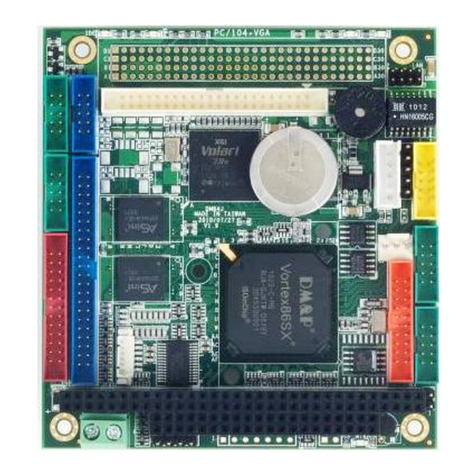
ICOP Technology
ICOP Technology VSX-6154-V2 user manual
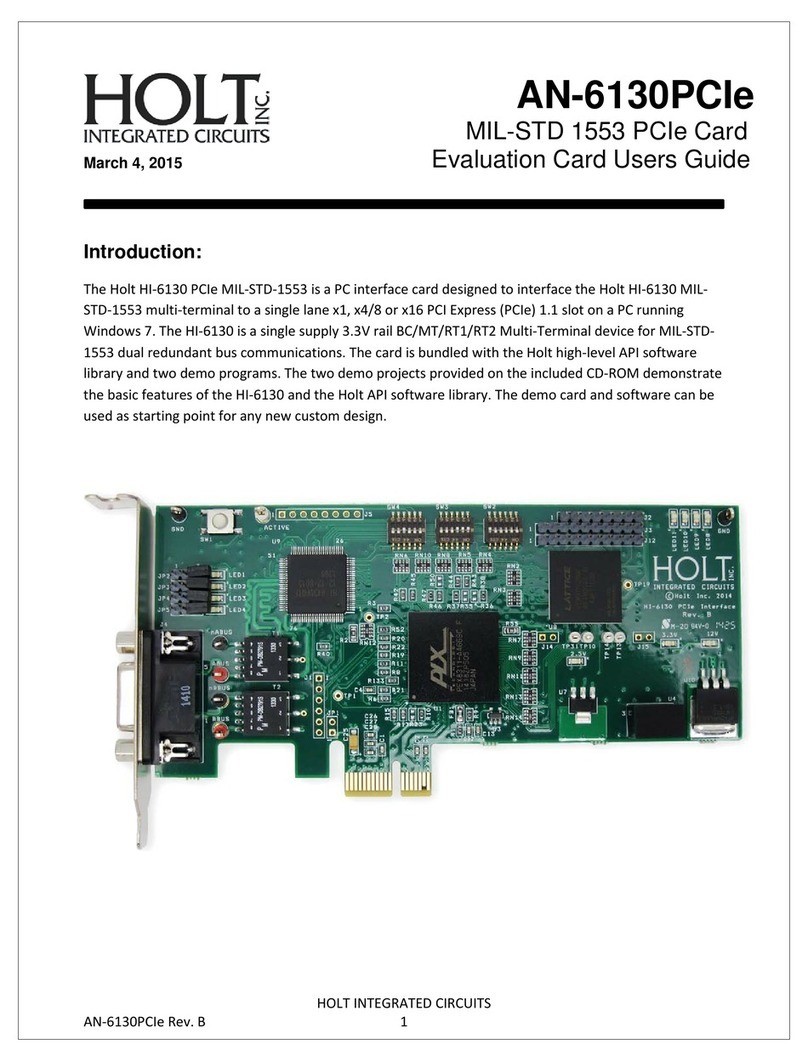
HOLT
HOLT AN-6130PCIe MIL-STD 1553 user guide
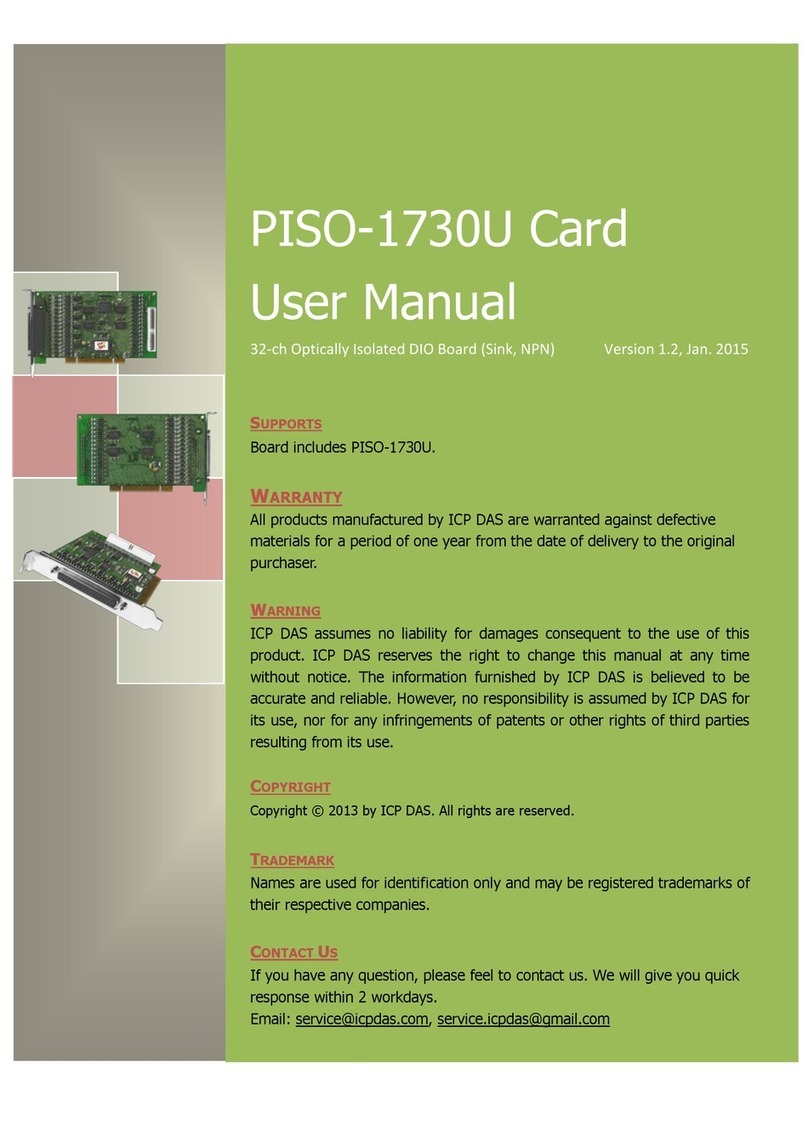
ICP DAS USA
ICP DAS USA PISO-1730U user manual

ZyXEL Communications
ZyXEL Communications AG-320 quick start guide

StarTech.com
StarTech.com PCISCSIUW instruction manual
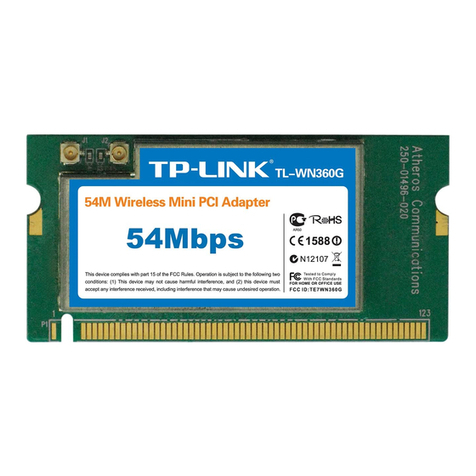
TP-Link
TP-Link TL-WN360G Specifications

